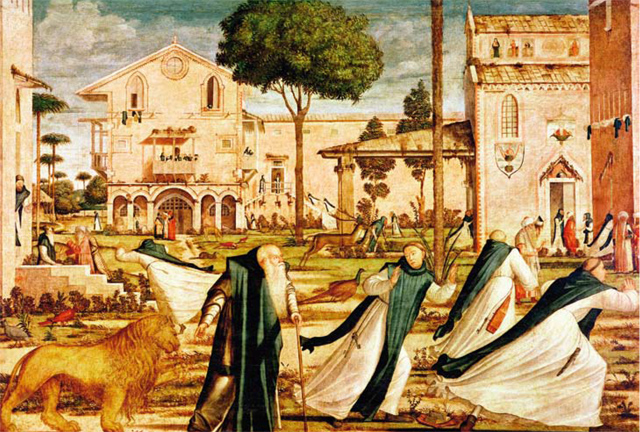My Favourite Painting: John Stefanidis
John Stefanidis chooses his favourite painting for Country Life.


St Jerome Leading the Tame Lion into the Monastery, from the cycle of paintings, 1502–07, by Vittore Carpaccio, in the Scuola di San Giorgio degli Schiavoni chapel, Venice, Italy. Bridgeman Images.
John Stefanidis says: ‘Of all the wonders of Venice, none has surpassed the pleasure given to me by this frieze of paintings by Carpaccio–and especially St Jerome and the Lion. They evoke Venice at the height of its glory. Orientalism is depicted in an imaginary fashion based on the reality of Venetian trade with the Levant, India and the Orient. The animals are particularly appealing, the buildings are architectural follies, the turbaned figures in brocade robes the epitome of elegance’
John Stefanidis is a leading interior designer whose projects include royal palaces and the Bank of England
Art critic John McEwen comments: 'John Stefanidis’s description of Carpaccio’s figures as ‘the epitome of elegance’ is apt, as he himself epitomises cosmopolitan style. Raised in Alexandria before the Second World War, he is multi-lingual, has lived in several countries and has seen most of the best art the world has to offer.
In his memoir, Designs, he says that Venice is ‘the most oriental of European cities’ (London unsurpassed for ‘cultural range’) and adds that, as a demonstration of affection, he often derives ideas for fabrics from Old Master paintings, for example ‘a pattern on the robes of the figures by Carpaccio’. The Venetian scuole were charitable institutions similar to the halls of our Livery Companies. San Giorgio was founded by the Dalmatians (Slavs), is modest in size and devotional in practice, and all the more charming for it. Ruskin describes the chapel in the two-storey building as ‘about the size of the commercial parlour of an old-fashioned English inn’.
There are 10 Carpaccios: seven of Saints George, Tryphon and Jerome and three New Testament subjects. George is so mythical that the Church no longer counts him a saint, Tryphon is an early martyr, and Jerome (347–420), an undisputed Dalmatian, is one of the great Church Fathers. Author of the vulgate (public) version of the Bible, he is the patron saint of translators, librarians and encyclopaedists. A scholarly acetic, St Jerome renounced his wealth for a hermit’s life. He removed a thorn from a lion’s paw, after which the lion became his household pet. He died in a Bethlehem monastery.'
This article was first published in Country Life, July 1, 2009
Sign up for the Country Life Newsletter
Exquisite houses, the beauty of Nature, and how to get the most from your life, straight to your inbox.
Country Life is unlike any other magazine: the only glossy weekly on the newsstand and the only magazine that has been guest-edited by HRH The King not once, but twice. It is a celebration of modern rural life and all its diverse joys and pleasures — that was first published in Queen Victoria's Diamond Jubilee year. Our eclectic mixture of witty and informative content — from the most up-to-date property news and commentary and a coveted glimpse inside some of the UK's best houses and gardens, to gardening, the arts and interior design, written by experts in their field — still cannot be found in print or online, anywhere else.
-
 Rodel House: The Georgian marvel in the heart of the Outer Hebrides
Rodel House: The Georgian marvel in the heart of the Outer HebridesAn improving landlord in the Outer Hebrides created a remote Georgian house that has just undergone a stylish, but unpretentious remodelling, as Mary Miers reports. Photographs by Paul Highnam for Country Life.
By Mary Miers
-
 380 acres and 90 bedrooms on the £25m private island being sold by one of Britain's top music producers
380 acres and 90 bedrooms on the £25m private island being sold by one of Britain's top music producersStormzy, Rihanna and the Rolling Stones are just a part of the story at Osea Island, a dot on the map in the seas off Essex.
By Lotte Brundle
-
 My favourite painting: Allan Mallinson
My favourite painting: Allan MallinsonMilitary historian Allan Mallinson picks an image of 'faith, generosity and ultimate sacrifice'.
By Charlotte Mullins
-
 My Favourite Painting: Piet Oudolf
My Favourite Painting: Piet Oudolf'One cannot sense whether he is far out on the ocean or closer to shore, or what he may be watching or feeling in that moment as he stares towards the beach.’
By Country Life
-
 My Favourite Painting: Mary Plazas
My Favourite Painting: Mary Plazas'There is compassion, awe, humility, a knowing yet a questioning in the glistening eyes. It moves me, it inspires me beyond the need to know.’
By Country Life
-
 My favourite painting: Robert Kime
My favourite painting: Robert KimeRobert Kime shares his fondness for New Year Snow by Ravilious
By Country Life
-
 My Favourite Painting: Anna Pavord
My Favourite Painting: Anna PavordAnna Pavord chooses a picture which reminds her of where she grew up
By Country Life
-
 My favourite painting: The Duchess of Wellington
My favourite painting: The Duchess of WellingtonThe Duchess of Wellington chooses her favourite painting for Country Life.
By Country Life
-
 My favourite painting: Maureen Lipman
My favourite painting: Maureen LipmanMaureen Lipman chooses her favourite painting for Country Life.
By Country Life
-
 My favourite painting: Jacqueline Wilson
My favourite painting: Jacqueline Wilson'I looked at this painting and decided to write about a Victorian circus girl one day'
By Country Life